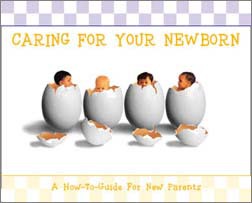A newborn needs many more hours of sleep than toddlers or older children. The National Sleep Foundation recommends that newborns get 17 hours of sleep each day for normal growth and brain development. On average, most newborns sleep a total of 18 to 20 hours daily, including short two to four hour naps. 12 to 15 hours of sleep per day is appropriate for four to 11 month olds.
Caring For Your Newborn
Table of Contents
Introduction
Congratulations!
Caring Begins at Birth
Your Newborn’s Hospital Check-up
Ten Fingers and Ten Toes
Special Care for Your Newborn
When Your Newborn Cries
Changing Your Newborn’s Diaper
Feeding Your Newborn – breast or bottle feeding
Feeding Your Newborn – spit ups, weight gain, BMs
Bathing Your Newborn
Dressing Your Newborn
Shhh!! We’re Sleeping
Keeping Your Baby Safe
Your Newborn’s Admirers
Taking Your Newborn Out
If Your Newborn Gets a Cold
If You Have Questions
Well-baby Check-ups
When to Call Your Pediatrician
Take Care of Yourself, Too

During the first few days of life, your baby may be very tired from the birth process, and sleep more than the recommended amount. To be sure he is getting enough to eat, it is important to offer feedings every two to four hours. When a baby goes longer than four hours without eating, the doctor may suggest waking him for feedings. He should also be fully awake while feeding. If you think your baby is sleeping too much, isn’t eating enough, or is difficult to wake for feedings, talk to your doctor.
 When you lie him down to sleep, always place your baby on his back. Remember the phrase “back to sleep.” Putting your baby down to sleep on his back decreases the risk of Sudden Infant Death Syndrome (SIDS). This is particularly important during the first 6 months when 95% of SIDS deaths occur. Letting babies sleep on their sides or stomachs has been strongly linked to SIDS. It is thought that these sleep positions impair airflow while breathing, and the “breathing center” of the brain is too immature to wake the baby up. In addition, never put your baby on a pillow to sleep, and avoid putting stuffed toys, blankets, or fluffy comforters in the crib. These soft surfaces are an asphyxiation risk for infants.
When you lie him down to sleep, always place your baby on his back. Remember the phrase “back to sleep.” Putting your baby down to sleep on his back decreases the risk of Sudden Infant Death Syndrome (SIDS). This is particularly important during the first 6 months when 95% of SIDS deaths occur. Letting babies sleep on their sides or stomachs has been strongly linked to SIDS. It is thought that these sleep positions impair airflow while breathing, and the “breathing center” of the brain is too immature to wake the baby up. In addition, never put your baby on a pillow to sleep, and avoid putting stuffed toys, blankets, or fluffy comforters in the crib. These soft surfaces are an asphyxiation risk for infants.
The baby’s bassinet or crib should have a firm mattress with a tight-fitting sheet. Keep his face and head uncovered while he’s sleeping so he can breathe easily. Avoid soft blankets, pillows, or any other extra bedding that could obstruct his breathing. Toys and stuffed animals can become hazards too.
Instead, keep your baby warm with a sleeper sac or warm pajamas, not a blanket. The American Academy of Pediatrics does not recommend using blankets in an infant’s bed until after the first birthday. If a blanket is used to swaddle a baby for sleeping, it should be wrapped snuggly around the chest and abdomen so as not to come undone or become a safety hazard. Care should be taken not to bind the legs too tightly which can cause hip problems. Swaddling should be discontinued once the baby first tries to roll onto the belly. It is also important not to overheat your baby with too many clothes or blankets which increases the risk of SIDS.
Be sure to discuss safe infant sleep practices with day-care staff, babysitters, and other caregivers. Show them how you want your baby to sleep. One third of daycare center SIDS deaths happen during the first week of attendance. An unintentional tragedy may occur if someone puts the baby to sleep on his stomach by mistake.
Sleeping on the back is important, but your baby also should pend time on his stomach to help strengthen neck and shoulder muscles. Doing so helps him learn head control, and prevents back of the head flattening. So, when your baby is awake and you are watching him, give him some “tummy time.”
Most babies begin a sleep-wake pattern during the first week of life. Some babies establish their day-night sleeping pattern right away. Other babies wake frequently throughout the night for six months or longer. While your baby is developing a sleep pattern, you can encourage him to sleep longer at night by keeping him awake during the late afternoon or early evening hours. If he tries to nap, talk or sing to him, or have some parent-infant playtime. Avoid car rides during these hours which can often lull an infant to sleep.
Let him get used to sleeping through everyday household noises. Avoid “tiptoeing around the house” while your baby naps during the day so that he begins to associate quiet with nighttime and sleeping. At bedtime, lie your baby in his crib after his diaper change, feeding, and as he begins to look drowsy. Keep the lights dim, and the nighttime routine quiet and without play. This routine should be consistent so that he learns when it is time for sleep. It’s OK for your baby to fuss a little before he falls asleep; you don’t need to pick him up each time he fusses. It’s good for him to learn to soothe himself to sleep.
Try to get some needed rest for yourself by sleeping when your baby sleeps. For nighttime feedings, ask your partner to bring the baby to you while you stay in bed and rest. When the feeding is over, your partner should take your baby back to his crib.
If you want your baby to be close to you, bring his bassinet or crib into your bedroom. Room-sharing is actually recommended by the AAP until the baby is six months old to reduce the likelihood of SIDS. However, your baby should not sleep in bed with you or your other children. He could suffocate or become injured by someone rolling onto him. Couches, chairs, and other soft sleep surfaces are also inappropriate. He may slide between the pillows or cushions, and suffocate or sustain an injury by rolling on to the floor.
 Tummy Time When Your Baby is Awake
Tummy Time When Your Baby is Awake
Your baby should sleep on his back, but spend time on his tummy when awake. Frequent “tummy time” will prevent a flat spot from forming on the back of his head, and help to build the muscles in his neck, shoulders, and arms. Never leave your baby alone while he is on his tummy as he may fall asleep.
Your baby can spend time on his tummy:
• while on the changing table, for one minute, after every diaper change
• when carried against your chest and shoulder; this gives him snuggle time, too!
• if you lie down and place his tummy on your chest or stomach; as he lifts his head, he can see your face.
• if you place a mat or blanket on the floor, then put him on his belly
It is important to change a baby’s position throughout the day, and avoid leaving him for extensive periods in a baby carrier or baby swing.
 Maintaining Normal Body Temperature
Maintaining Normal Body Temperature
Helping your newborn keep a steady temperature is very important. If not, calories that he needs for growth and weight gain may be instead used to keep warm or stay cool. A newborn’s body temperature goes up or down quickly as the temperature around him fluctuates. Therefore, how he is dressed, and the location of the crib or bassinet can affect your baby’s body temperature. If his crib is in a drafty room, under a ceiling fan, or near an air conditioning vent, your baby can lose body heat. In response, his body will try to create warmth by using body fat and calories needed for normal, healthy growth. Placing the crib near a heater or in front of a sunny window cause your baby to become too warm. An overheated baby is at risk for SIDS.
When an infant is too cold, the hands and feet will feel cold, and may appear a bluish color. This is because the blood vessels of the hands and feet constrict to conserve heat in the rest of the body. A baby that is too hot may have flushed cheeks and sweat on his head. A fussy baby that can’t be soothed by feeding or being held may feel uncomfortably warm or cold. If there is a ceiling fan in your baby’s room, keep it on a low setting, and place the crib away from where is directly blows air. The temperature of your baby’s room should be kept between 67°F and 72°F.